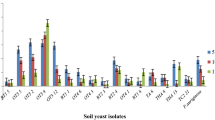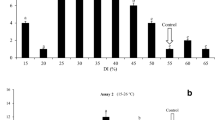Abstract
Yeast isolates were obtained from the brewer's stock of the Guinness brewery in Benin City, midwestern Nigeria, and from local sources such as mango and sugar cane. The fruits were exposed to the immediate soil environment in eleven selected sites in the Ugbowo and Ikpoba Hill areas of Benin City, Edo State of midwestern Nigeria. A total of twenty-seven yeast isolates were obtained. Fourteen isolates were identified as Saccharomyces cerevisiae and 13 as S. carlsbergensis. Analysis of resistance to copper sulphate revealed that the two brewer's yeast isolates were resistant to 3.5 mM and 4.2 mM CuSO4, respectively, while the local yeasts were resistant to higher concentrations ranging from 6.5 to 16.5 mM. The percentage copper sulphate resistance of yeast isolates obtained from Mangifera indica ranged from 52.4 to 73.8%, while the percentage copper sulphate resistance of yeast isolates obtained from Saccharum officinarum ranged from 51.8 to 62.6%. The two brewer's yeast isolates (BY2 and BY4) had a percentage CuSO4 resistance of 32.4 and 38.5%, respectively. Comparison of soil copper concentration and copper resistance levels in selected yeast isolates indicated that the soil copper concentrations generally influenced the ability of yeasts to resist copper.
Similar content being viewed by others
References
Do Carnio-Sousa (1969) Distribution of yeasts in nature. In: Rose and Harrison (eds), The Yeast, pp. 83. New York: Academic Press.
Miller MV, Phaff JH (1962) Distribution of yeasts in nature. In: Rose and Harrison (eds), The Yeast, Vol. 1, pp. 83–88. New York: Academic Press.
Soumalainen H, Oura E (1971) Yeast nutrition and solutes uptake. In: Rose and Harrison (eds), The Yeast, Vol. 2. p. 4. New York: Academic Press.
Lindegren CC, Lindegren G, Shultz E, Hwang YL (1962) Nature (London) 194: 260–265.
Fogel S, Welch JW (1982) Tandem gene amplification mediated copper resistance in yeast. Proc Natl Acad Sci USA 79: 5342–5346.
Ekundayo EO, Obuekwe CO (1997) Effects of an oil spill on soil physico-chemical properties of a spill site in a Typic Paleudult of midwestern Nigeria. Environ Monit Assess 45: 209–221.
Olasupo NA, Scott-Emuakpor MB (1991) A comparative study of industrial and local yeast isolates. Acta Biotechnologica 2: 237–244.
AOAC (1975) Association of official analytical chemists, 11th ed. Washington DC: Association of Official Analytical Chemists.
Author information
Authors and Affiliations
Rights and permissions
About this article
Cite this article
Ekundayo, E., Obuekwe, C. The relationship between soil copper content and copper resistance in yeast of an ultisol in midwestern Nigeria. Plant Foods Hum Nutr 53, 175–181 (1998). https://doi.org/10.1023/A:1008063706325
Issue Date:
DOI: https://doi.org/10.1023/A:1008063706325




